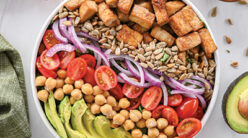Recently, as I entered the fitness center in my community, a large pop-up banner caught my attention and caused me to raise an eyebrow. The headline read: “Juice Boxes. Not worth the squeeze. 1 box=10 chocolate candies.” To illustrate the point, pictured on the banner were 10 chocolate candy kisses equated with a small juice box. I was amazed to learn that those little juice boxes that advertisers tout as a healthy alternative contain 20 grams of sugar—the equivalent of five packets, or five teaspoons, of sugar. Now curious, I did some fact checking: Even a tiny 4.26-ounce box of 100 percent juice (with no sugar added) contains 16 grams—or four teaspoons—of sugar, approaching the six-teaspoon daily limit recommended by the World Health Organization. No wonder fruit juice and other beverages are often described as liquid candy!
It is estimated that the average American consumes about 22 teaspoons of sugar daily—that’s more than three times the amount of sugar that is considered acceptable. Numerous scientific studies have shown that excess sugar consumption is associated with obesity, non-alcoholic fatty liver disease, insulin resistance, type 2 diabetes, high blood pressure, heart disease, gout, elevated uric acid levels, certain types of cancer, and elevated cholesterol and triglycerides.
Sugar consumption can even affect your appearance and how you age. A study conducted at Leiden University Medical Center in the Netherlands and Unilever in the United Kingdom found that people between the ages of 50 and 70 who had high levels of blood glucose looked older than those of the same age who had lower glucose levels.
Eating sugar also creates a can’t-win cycle: Certain types of sugar, specifically high-fructose corn syrup, can stimulate hunger, and, consequently, affect how much food we eat. According to findings by Yale School of Medicine, “fructose possibly increases food-seeking behavior and increases food intake.” In other words, the more sugar you eat, the more you want to eat . . . and eat . . . and eat. And it’s not just more sugar that you eat; it tricks you into feeling hungry for all kinds of food.
Robert Lustig, M.D., a pediatric neuroendocrinologist at the University of California San Francisco who has conducted clinical research on diet, lifestyle, and health outcomes, firmly believes that the increase in sugar consumption has led to the current obesity crisis. He asserts that excess sugar consumption sets up a vicious cycle by driving fat storage while also making the body think it is hungry. According to Lustig, all forms of sugar are poison. “High-fructose corn syrup and sucrose are exactly the same. They’re equally bad,” he says.
So how can you cut all that added sugar from your diet? Here’s a good starting point:
• Don’t believe the hype.
You’ve likely heard the research about the dangers of soda, including their connection to obesity, diabetes, and other serious health problems. But fruit juice—especially with no added sugar—is supposed to be a healthy choice, right? As I learned from that pop-up sign, just because a company’s marketing department is telling you their product is healthy, doesn’t mean it’s true. For the healthiest option, avoid processed, packaged foods as much as possible, and increase your consumption of whole foods in their natural state. For example, orange juice may be better for you than orange soda—but an actual orange is the best choice.
• Hunt down hidden sugar.
Sugar can be hidden in places you’d least expect, so you’ll need to learn to be a label reader. A small granola bar, often considered a healthy option, can have as many as 25 grams of sugar, which is more than the recommended sugar intake for the entire day. Other foods with unexpected sugar include salad dressing, ketchup, barbecue sauce, yogurt, canned fruit, restaurant food, and frozen entrees. Remember that sugar can be labeled many ways, including molasses, dried cane syrup, brown rice syrup, invert sugar, sucrose, dextrose (or any name ending is “-ose”).
• Try healthier alternatives.
What’s a special occasion without a cake, cookies, or a sweet treat? Fortunately, you don’t have to give up celebrating when you cut back on sugar. Make your own healthier desserts sweetened with stevia or dates (but don’t use artificial sweeteners, which, surprisingly, can cause weight gain). Scan Pinterest or the internet for tasty ideas. For everyday sugar cravings, grab a piece of fresh fruit or a small handful of raw almonds or walnuts. Fruit and nuts are packed with nutrients and fiber and also help to create a feeling of satiety.
• Give it time.
As you cut back on your sugar intake, you’ll be surprised how your taste buds change and how much better you feel. After doing a 21-day challenge of eating healthy foods and no added sugar, I felt more energetic—and no longer craved sweets. In fact, when I tasted a sugar-sweetened dessert after a few weeks off of sugar, it seemed sickeningly sweet!
Pat Humphrey lives in southeast Oklahoma, where she pursues her passion of helping people to lead healthier lives.






